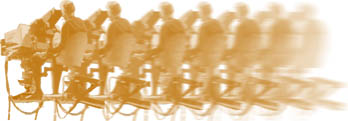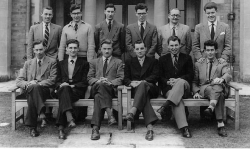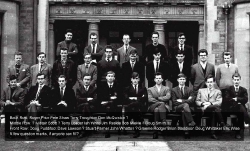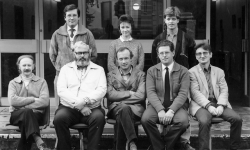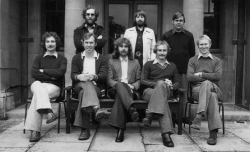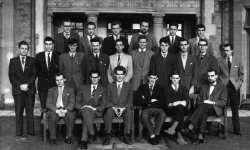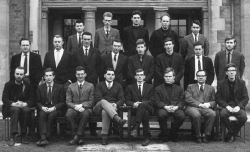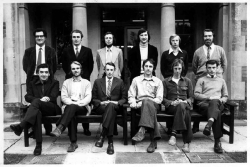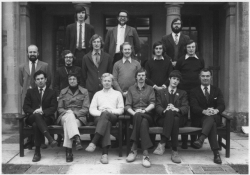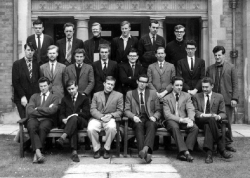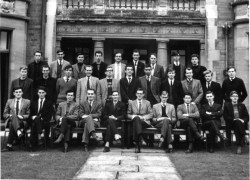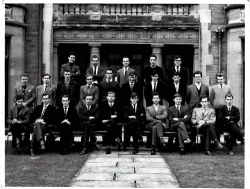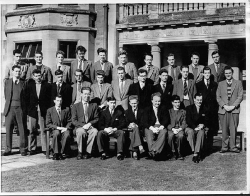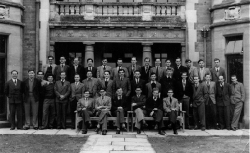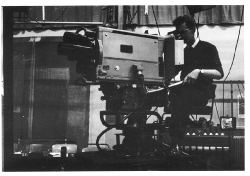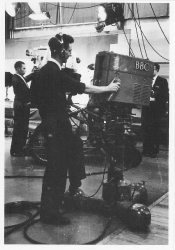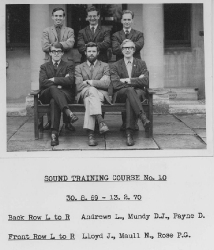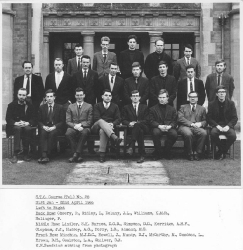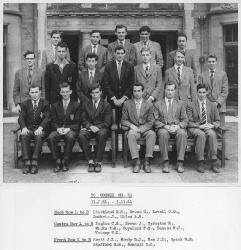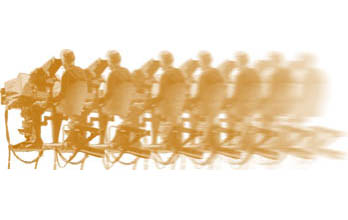From Patrick Heigham
Memories of Gram operating in the sixties
I became a Gram Op in order to be able to park. No kidding! In the days before the BBC multi-story, (and I left before the builders’ cleavage had reached puberty), there used to be ample parking at TVC. Behind the scene block, reached from Frithville Gardens, and in front, to the right of the original reception entrance, was a very useful area, open to all and sundry.
However, the extension to TVC, containing TC 6 onwards, encroached upon this ground and so a system of car passes came into force, with a daily quota available to be split between departments. Since there was a shortage of both rehearsal facilities and sound editing rooms (i.e. the galleries), one of the job grades to be allowed a permanent car pass was that of the Gram Op, as we used our cars to attend ‘outside rehearsals’, also to reach edit or recording facilities at BH or even Bush, subsequently bringing the precious tapes safely back to TVC.
So, following John-John Eden-Eadon’s wise advice to apply for Grams Training, I became attached to Bish (Adrian Bishop-Laggett) – well, he was a very nice bloke, anyway! Bish was then pioneering the task of supplying the ‘noises-off’ for Dr. Who, and indeed, the very first story introducing the Daleks!
Shortly after I joined the show, Bish moved on to become a Sound Supervisor, and I was left in charge of a huge library of effects and the job of liasing with Brian Hodgson of the RadioPhonics Workshop at Maida Vale.
From the Tape deck of the Tardis, let me take you on a journey back in time, to tell some of today’s operators: ‘How it USED to be done’
Each weekly episode was usually recorded on Fridays, with a midweek visit to the outside rehearsal in some drill hall which could be anywhere from Acton to Wandsworth. Having discussed final ideas with the Director, it was back to TVC for a session in the Gram Library, a quick beer and sarnie in the Club and thence to Lime Grove and Studio R. Studio R was a dedicated sound-only studio, control room and machine room with tie-lines to CAR in both audio and vision. In my time, it was equipped with three or four Leevers-Rich ¼” decks and the most irritating cross plugging matrix panel of multi-pin F & E sockets, which carried both ins and outs simultaneously. How much better were the TVC patch panels using double-enders to connect exactly what you wanted where. Studio R also had its own ‘hermit’ – Jack Timms – an ex-Decca man for whom the BBC had found this niche. He used to work solely in this facility, doing any odd job for which programmes might not have had a dedicated Gram Op.
He liked Wednesdays, for I had exclusive use of Studio R for the afternoon, and he could go home!
My task was normally to prepare and shuffle all the required effects onto various spools for playing in on the night.
I used to try and insist that whichever studio we were in, could have EMI TR90 decks for replay, as these had an amazingly fast start, which made cueing of spot effects synchronised to action, a better possibility.
Leevers-Rich had horrible habits of either wow starting or stretching the tape. I was allowed three tape decks, together with the standard four disk turntables (modified Garrard 301’s with quick start mechanisms), and in the early days when the show was based in Studio D, a six-channel outboard mixer, through which all the effects sources were routed, owing to the woefully inadequate channel facilities of the installed desk.) Somewhere I have some illicit 8mm cine film of the lash-ups we used to construct, including a long atmos tape loop that stretched across the sound gallery and round a cine spool with a pencil spigot!
During the Dalek episodes, all the distinctive voices were usually supplied by Peter Hawkins, and were there a need for multiple Dalek ‘players’ then some dialogue tracks were pre-recorded and played in by yours truly. Therefore I became an Actor, since accurate timing, if not the delivery, was paramount since I was playing opposite real folk in the studio. I remember leaving Debbie Watling, then playing the Doctor’s sidekick, with egg-on-her-face, as I glanced at my script to check the next sequence, and nearly forgot to play in the final reply line to her dialogue!
I normally arranged all effects or music stings of finite duration on the first spool, then split atmospheres and background music between the other two machines. Mostly I had the facility of twin-track decks, but a few pool machines were full-track only, which sometimes caused panic and necessitated a rapid re-think.
If the programme had recording breaks, then music cues running over the join were dubbed on later. The VTR tape was edited by cut and splice, then.
In the very early days, Lime Grove galleries were fitted with 78rpm turntables, with parallel tracking pickups, and old-fashioned steel needles. It being impossible to back track the discs, one had to groove count before the mod of the effect happened, either by counting turns from the run in, or by gently clicking the needle from groove to groove, on pre-hear. If you got it wrong, it was either late, or halfway through! Later, the DRD5, equipped with a stereo stylus that had vertical compliance, allowed the disc to be rotated backwards from the start of the effect and so cued in with a bit of anticipation. This seems to be the mainstay of the exponents of today’s scratching DJ artistry, but let’s face it, chaps, it’s not new!
The time of which I speak was around 1963 – 65, nearly FORTY years ago, we had fun doing it; with wobbly polystyrene sets, we tried hard to create a fantasy, which has since become a cult. What would I have been able to contribute with the use of audio delivery systems off the hard drive of a computer?
Pat Heigham (Tech Ops TVC 1962-68)
…………………………………….
From Terry Brett
How I got into lighting sooner than I intended. . . .
The scene is studio R2 (Riverside) on a Saturday afternoon with BBC2’s brand spanking new alternative to sport, ‘Open House’. Both Riverside studios were used to produce this magazine show hosted by Gaye Byrne, of the ‘Late Late Show’ on RTE. Stewart Morris produced the show (shudder!).
There I was, a mere stripling of a lad, doing one of his first cameras. Standing behind a Pye Mk5 camera on a spring ped with a Varotal Zoom.
Unfamiliar with this combination? Well aren’t you the lucky one! For the uninitiated the spring ped was a cheap alternative to the Vinten gas peds and used springs to balance the weight. They were exceedingly heavy and the column range was negligible. The Varotal zoom was a bolt on device with cable operated zoom and focus. Not the most responsive device as it seemed you had to take up the cable slack before anything happened and then overshot at the end.
Well here we are on air, a fashion display. Model walks forward with your truly tracking back in front of her. Yes tracking, we didn’t really believe in zooming anyway in those days. Suddenly the ped grinds to a halt. Cameraman and model start to panic. The floor in R2 was notoriously uneven and the ped had stuck to the floor. I, a shadow of my present self, hadn’t the weight to shift it. Stu Lindley came to the rescue and with a bump we were off again, accompanied of course by the kind of sympathy only Stewart Morris can provide.
So a very young cameraman, nerve totally gone, faces his next task – a black tap dancer, dressed in black dancing on a black floor! This man was like Sammy Davis Jr. on speed. Guess who had to do the close ups of his feet? Yup, and remember what I said about the zoom? Well with that combination not much was in focus of course – more encouragement from Mr Morris.
Shortly after that I was called to see Gwillym Dann and asked if I would like to join the Vision Section. . . . . .
…………………………….
This is one of mine (Bernie). It isn’t strictly a tech-ops story….
In the early nineties I was asked to be the BBC’s maker of commercials. Somebody had decided that it was ok to sell books records and tapes on BBC1, provided the BBC had made them. I counselled against this, as a senior Pres producer – I thought it was bad politics. I said my piece and went on leave. When I came back, they had not only ignored me, but decided I was the person for the job.
As it happened, it was something I loved doing. I had been told off for doing on Radio Times “trails” in the past – they were supposed to hint at the possibility of buying, rather than actually kicking the punters in the teeth, and I was always too gung ho.
One day they wanted us to sell a diet book, and they asked for something simple and direct. I decided that a bikini-clad model in Pres A (the camera was operated by tech-ops) was just what was needed. She would have just one line to say.
I had no idea where to get models from. It was the height of political correctness around our department, but I asked our lady booker of artistes. She didn’t turn a hair, and gave me the numbers of several specialist agents. So I rang one. I explained to the rather camp voice that the model should look like the girl next door, rather than a sex siren, and that I would need to see the girl first before I put her on the air. He said no problem. Look in the catalogue he would send, pick some likely girls, as many as I wanted, and he would send them over so I could pick one. No charge, just pay the successful one the standard rate for the job.
So I picked half a dozen, got them in to Pres A in their bikinis, asked them to read the line, looked them over and selected one. It all went very well, apart from the embarrassing experience in reception.
The first girl arrived a bit early. I went down to collect her, and decided we should sit there and wait for the others. We made small talk in a crowded reception for a few minutes, and then she said “Would you like to look at my portfolio?” – a large folder she had brought with her. “Ok”, I said, and she opened it up. The pictures were very tasteful, provided you don’t mind full frontal nudity in 10×8 black and white with the world and Michael Palin sitting around you, whilst talking to the person featured in all her glory. “Very nice”, and “That one’s good” I said, flicking through.
It turned out that she worked in Boots mostly, thought she had done page 3 and really wanted to be a model. And she got the job, because she could actually say the line and look like the girl next door in her bikini.
The Monopolies and Merger Commission stopped the BBC making commercials a few months later. I told them so…
?